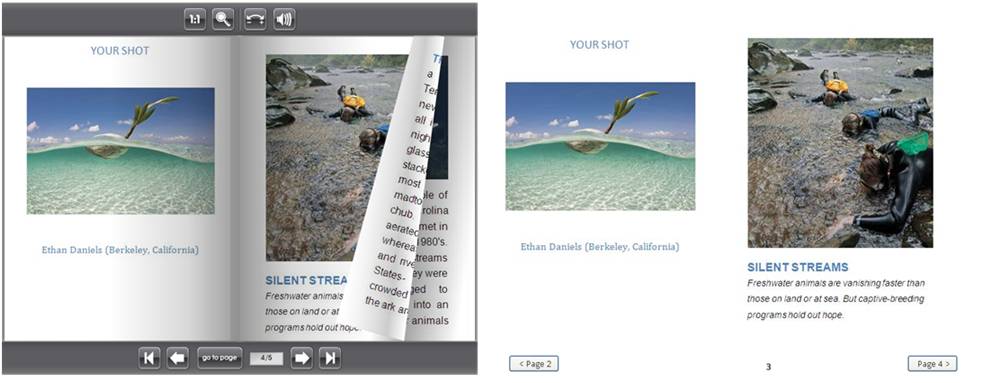Media Effects Research Lab - Research Archive
The impact of flipping modality on civic engagement
Student Researcher(s)
Ji Young Lee (Ph.D Candidate);
Jeeyun Oh (Ph.D Candidate);
Harold Robinson (Ph.D Candidate);
Faculty Supervisor
INTRODUCTION
This study aims to reveal the impact of a flipping modality on civic engagement as well as the underlying mechanism which drives the relationship between the technological factor and the level of civic engagement. Based on MAIN model (Sundar, 2008) and the concept of attitude accessibility (Arpan, Rhodes, & Roskos-Ewoldsen, 2007), an online experiment (2 (flipping vs. non-flipping) ? 3 (old media heuristic accessibility vs. coolness heuristic accessibility vs. control)) tests the impact of flipping modality on the degree of absorption, recognition memory, attitude towards content/website, and behavioral intention of civic engagement.
RESEARCH QUESTION / HYPOTHESES:
H1: Presence of flipping modality would positively influence the quality perception of content by triggering old media heuristic and coolness heuristic.
H2: Presence of flipping modality would positively influence the quality perception of website by triggering old media heuristic and coolness heuristic.
H3: The positive effect of flipping modality on dependent variables would be greater when participants are accessible to old media heuristic than when they do not have accessibility.
H4: The positive effect of flipping modality on dependent variables would be greater when participants are accessible to coolness heuristic than when they do not have accessibility.
H5: Presence of flipping modality would positively influence the quality perception of content, which in turn, lead to positive behavioral intention towards website.
H6: The effect of flipping modality on quality perception of content would be positively mediated by the degree of absorption on website.
H7: The effect of flipping modality on quality perception of website would be positively mediated by the degree of absorption on website.
RQ 1: What is the effect of flipping modality on participants’ memory of media content?
RQ 2: What is the relationship between the presence of flipping modality and the degree of civic engagement?
METHOD
A 2 (flipping vs. non-flipping) X 3 (old media heuristic vs. coolness heuristic vs. control) between-subjects experiment was conducted via online from April 17 to April 24. Both flipping and non-flipping eZine web pages had an identical article with several related photos. The flipping eZine enabled participants to click and drag the corners of the pages to flip through them as well as move through pages by double clicking, whereas non-flipping eZine allowed participants only to click the next page button to proceed. In particular, participants in the flipping condition were asked to turn the volume up on the computer and try to click and drag the corners of the pages to flip through them by an instruction. Figure 1 shows screen shots of flipping and non-flipping condition.

Figure 1. Screen shots of flipping vs. non-flipping condition.
Participants in old media/coolness heuristic condition were asked to think about their previous positive experience with print media/cool media and to indicate their attitude toward those media. This procedure referred to previous research on attitude accessibility (e.g. Roskos-Ewoldsen, Bichsel, & Hoffman, 2002). Participants in the control condition were asked to think about positive experience with restaurants they like, which was hardly related to attitudes towards media.
The news article chosen as the stimulus material was pre-tested to maintain neither too dramatic nor too boring content. The article titled “Silent Streams” from the April issue of National Geography magazine was used as stimuli.
RESULTS
Flipping modality was found to create positive evaluation on website and behavioral intention towards the website. Flipping through eZine led people to think the website as more sophisticated, organized, and user-friendly compared to just clicking next button to read it. The reason people responded in this way was that they reminded about the coolness of medium while they were flipping eZine, which in turn, made the interaction with eZine more absorbing and interesting experience. Similarly, flipping created more behavioral intention to forward and revisit the website by making people think about coolness and by producing positive evaluation of credibility and enjoyability of content. In terms of attitude towards content and civic engagement, however, participants who flipped through the website showed positive responses only if they reminded about coolness of medium while reading eZine. In addition, people showed less recognition memory when they flipped through eZine than when clicked through it.
DISCUSSION/ CONCLUSION
In general, our results suggests that the way people access to medium makes a critical difference in terms of users’ perception and behavior. Flipping modality seems to create positive responses regarding the website, but a closer look at content perception and civic engagement points out the possibility of negative effects for flipping. One of the most interesting findings through this research is the positive and exclusive mediation effect of coolness heuristic on attitude towards content and civic engagement. This shows that heuristics about technology plays a significant role in deciding which effect flipping creates finally. For instance, young users like undergraduates in this research would engage to solve a civic issue presented in a new interface only when they had an opportunity to remind coolness of the medium and in turn, had positive attitude towards content. Without triggering coolness heuristic, newer interface such as flipping modality rather negatively adjust their intention to participate in civic issues. Thus, this result supports MAIN model (Sundar, 2008)’s prediction which explains heuristics triggered by technology can decide the overall evaluation of media content.
For more details regarding the study contact
Dr. S. Shyam Sundar by e-mail at sss12@psu.edu or by telephone at (814) 865-2173

